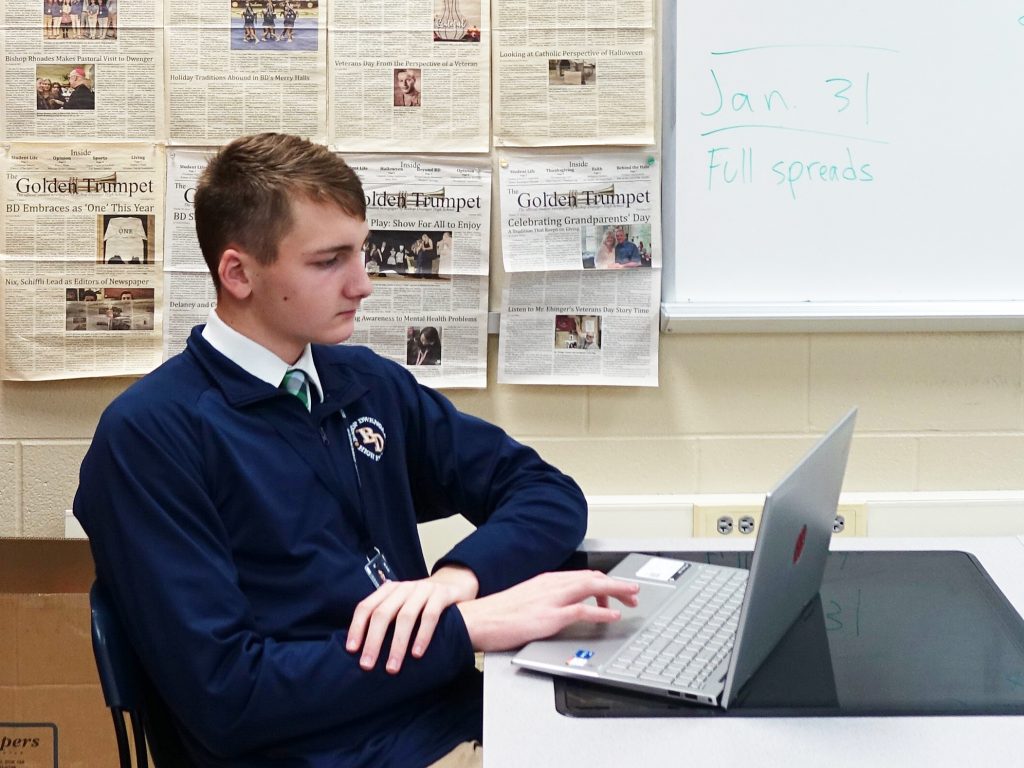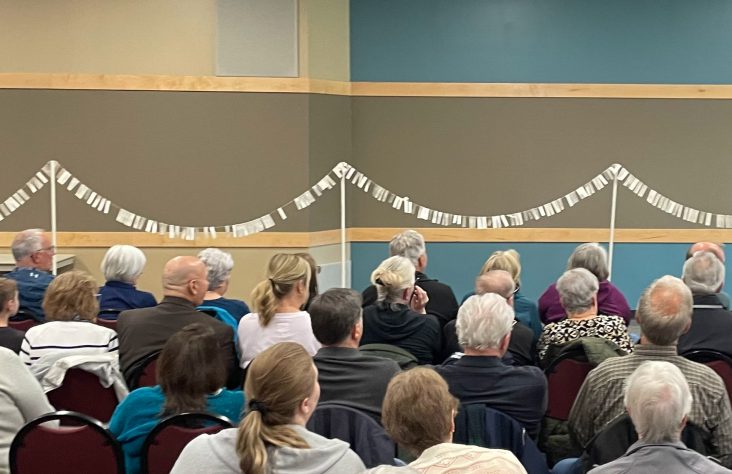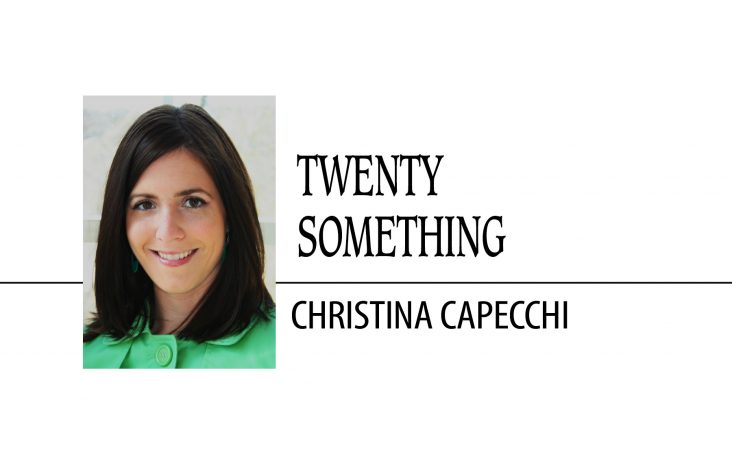January 30, 2024 // Diocese
From the Classroom to the Newsroom: Students Learn the Importance of Journalism
While the modern landscape of journalism continues to change, many Catholic schools in the Diocese of Fort Wayne-South Bend are engaging with media that both entertain and inform the communities they serve – whether through clubs or electives, through print newspapers or broadcasts where students are able to be reporters and news anchors.
In February, the Church celebrates Catholic Press Month, designated by the Catholic Media Association to honor the work being done by Catholic journalists across the United States and abroad to inform and inspire. The Catholic press has a long history in the Diocese of Fort Wayne-South Bend, beginning in 1912, when Father John F. Noll purchased a printing press and founded the national Catholic newspaper Our Sunday Visitor to correct disinformation about the Church that was rampant at the time. As bishop of Fort Wayne, in 1926, Bishop Noll oversaw the establishment of the newspaper that is now Today’s Catholic.

Photos by Kasia Balsbaugh
Jakayla McKeel, left, a junior at Saint Joseph High School in South Bend, and Vivian Glavich, a sophomore, edit videos for their media class on Monday, January 22.
At schools across the diocese, students and their advisers continue to carry on this legacy.
Phil DePauw, an alumnus of Saint Joseph High School in South Bend, remembers the days when there was a student-run print newspaper, The Highlight. After DePauw returned to Saint Joseph as a teacher, he began a student media class focused on video production. When DePauw came across a way to publish stories online, he told Today’s Catholic that “going printless was a good way to go. And then the pandemic happened, and I really thought it was a good idea.” His class founded and now operates The Square, a website for student-written articles and musings.
DePauw’s students rotate assignments, giving everyone a chance to write articles, take videos and photos, and broadcast morning announcements. Daily announcements at Saint Joseph High School are 10-minute affairs broadcast to the whole school informing classmates of assignment deadlines, club events, sports highlights, announcements from the principal, and a joke of the day.
“I kind of wanted to be on the announcements,” sophomore Vivian Glavich said when asked why she took the elective class. Many of DePauw’s students had similar motivations for joining the class. Senior Sara Prokop, for instance, said she loves anchoring, and this is her second time taking the class she initially signed up for on a whim. Speaking in front of a camera, Prokop said, is “easier” than speaking in front of people.
At Bishop Dwenger High School in Fort Wayne, English teacher Greg Jones’ student media class runs similarly to DePauw’s. Jones’ class, however, is more print-focused. Though the class does audio and video announcements, its main productions are the yearbook and the school’s monthly newspaper, The Golden Trumpet.

Bishop Dwenger sophomore Nicholas Kleber works on a project in media class on Wednesday, January 24, as copies of The Golden Trumpet, the school’s newspaper, hang on a wall behind him.
A common theme among media students in both schools was interest in covering sports. At Saint Joseph High School, junior Berkley Zache, who has committed to play softball for the collegiate powerhouse University of Oklahoma, told Today’s Catholic she joined the class because she was interested in learning to cover the softball team. Bishop Dwenger junior Mason Voglewede said he took the class to gain experience in sports broadcasting. Voglewede said he has been involved in sports broadcasting since age 8. His favorite sports to cover at Bishop Dwenger are basketball and hockey. “They’re fast paced,” Voglewede said, “and it’s fun to talk fast.”
Saint Joseph High School alum Jacob Morris is currently a sports reporter for television station KNWA in Fayetteville, Arkansas, where he primarily covers the University of Arkansas Razorbacks. “As my mom describes it, I’ve been obsessive about sports from a very young age,” Morris said. “My first memory I have is watching the national championship game at age 5 with my dad. … From that point on, it was kind of my life, for better or worse.”

Sports broadcaster Jacob Morris fulfills a childhood dream by standing in the Alabama Red Tide stadium. Morris graduated from Saint Joseph High School.
Morris never thought his love for sports broadcasting could become a career until his mother encouraged him to attend a sports media camp during high school. He graduated from Syracuse University with a journalism degree in 2023. Morris is still in disbelief that he gets to do full-time what he loves so much, saying that it’s “quite ridiculous that it’s something I can do for work.”
Morris credits his time in DePauw’s class at Saint Joseph. “I loved it so much I took it both semesters,” Morris said. “That was phenomenal.”
“As a 17-year-old, a large part of what made it so memorable was the way it was taught,” Morris remembered, saying that no other class afforded him the opportunity to edit video, or run an audio board, or “go to this basketball game and interview these players to air in the morning announcement.”
Morris said he was grateful for DePauw and his class. “He was always pushing to find a new way to go about things, pushing students in the class to pursue passions, which is kind of the best quality a teacher can have,” Morris said.
While sports and broadcasting may still be alive, many teachers and students made note of the decline in other forms of journalism. “There are students in high school now who have never picked up a newspaper in their life,” Morris said. However, Morris said, “Telling a story and getting somebody’s story out there is kind of what journalism is supposed to be at its core. It’s important that we don’t entirely lose that.”

Provided by St. Louis Academy
Students at St. Louis Academy in New Haven work on the upcoming issue of The Crusader Credits, the school’s newspaper, which began this year under the direction of middle school English teacher Elaine Smith.
Teachers see this playing out in their high school media classes. At Bishop Dwenger, Jones pointed to the decline of print journalism as to why he left his 28-year newspaper career to begin teaching.
“I love doing it,” Jones said of his journalism career. “What I got tired of doing was walking in every day and not knowing whether I was going to have a job or not.” After serving as a student-teacher at Bishop Dwenger, Jones said, “My backup plan became my primary plan.”
Librarian Mary Dlugosz, who oversees the journalism club at Marian High School in Mishawaka, has also noticed a difference in the way students have engaged with journalism through the years.
“I think of myself with social media, they express themselves that way now,” Dlugosz said. Her club is responsible for producing Marian’s student newspaper, The Lance, which is published online for members of the school community. “I try to tell them that the yearbook, something of that caliber, it’s a historical record, you want that in print,” Dlugosz said.
Dlugosz also said she has seen declining interest in long-form story writing, or even interest in writing news stories. She remembered past students being more interested in writing on serious topics such as world politics. “Now, there are more fluff pieces,” said Dlugosz, who doesn’t blame this lack of interest solely on social media. Some of the lack of commitment, she said, is because of testing and “academic pressures” kids are under today. “There are lots [more] demands on students and their time nowadays than when I was in school,” Dlugosz said.
Jones has seen this in his class as well. He said his media class is mostly sophomores, and he credits busier, more career-focused schedules in junior and senior years for that. He pitches his class extensively throughout the year to keep students signing up.
However, Jones’ student editors-in-chief have stuck around for their junior and senior years. Junior Catherine Hill, one of the co-editors, hopes to go into restorative architecture as a career, but said she very much enjoys the media class. Her responsibilities are many: Besides working on articles and page layouts, she and her co-editor delegate tasks to other students in the class. Students go through her first, Hill said, before going to Jones with questions or assignments.
Besides the fact that she enjoys the work, Hill said the class has provided her with helpful knowledge. “It’s improved my communication skills and pushed me out of my comfort zone,” said Hill, who added that she’s had to get used to talking to students she doesn’t know, as well as making phone calls, writing emails, and taking photographs.
Other classmates enjoy journalistic work as well. Bishop Dwenger sophomore Mady Smith said she really wants to be an archivist, but that journalism is “something I would definitely consider.”
Sophomore Samantha Ondecker also said she enjoys experiencing different activities such as graphic design and photo editing. “It’s giving me more options with what I want to do with my future,” Ondecker said.
“Whether they’re going into journalism or not, this class has a lot of skills that they can utilize in other professions or majors or job situations,” Jones said, giving the examples of “work ethic, organization, responsibility.”
As Dlugosz sees it, the benefits of journalism classes include having students work under deadlines and “produce something themselves.” But the habits journalism inculcates have an even broader significance.
“We want them to be informed citizens, not only of the earth but also of heaven,” Dlugosz said. She added, “When they go to college, we don’t want them to say, ‘They were hiding this from us.’”
Dlugosz sees the critical thinking and truth-seeking skills used in journalistic work to be “compatible” with spiritual growth and with examining personal questions and Church teachings.

The front page of the November 2023 edition of The Lance, Marian High School’s student newspaper.
“Our job is to help kids see,” Dlugosz said.
And even though interest in journalism careers may be waning, some school programs are just beginning. Elaine Smith, middle school English teacher at St. Louis Academy in New Haven, began a student newspaper club this academic year because of student interest. Her students, ranging from fifth to eighth grade, put out their first issue of The Crusader Credits just before Christmas. They covered stories from the parish picnic to the school’s fall fundraiser to a student reporter favorite: student and teacher spotlights. “I enjoy seeing them get excited about writing,” said Smith, who added that the students buy in partly because “they get some choice in what articles they write about.”
For Smith, the benefit of engaging Catholic school students with journalism involves helping them focus on the right things. “I think it’s important for them to be able to write about their faith and write about what is important to our school and our community,” Smith said.
In media classes and clubs, the students are learning how to write and communicate clearly, the importance of being accurate and truthful, of prioritizing deadlines. They are entrusted with technology, interviews, and school publications – even information itself.
“We have everything a journalist would need,” Jones said. “These kids do a lot; they design, they write, they take pictures,” Jones added. “While they’re in this class, they’re student journalists.”
The best news. Delivered to your inbox.
Subscribe to our mailing list today.






